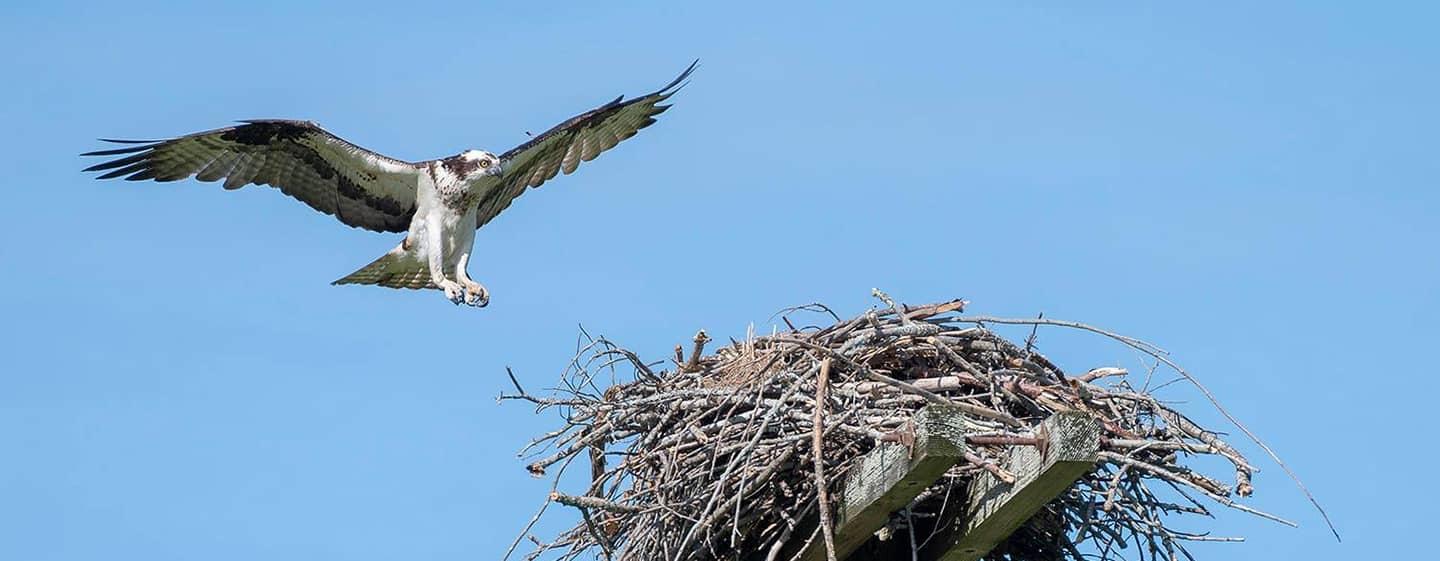Lake Norman’s Famous Ospreys Return to Nesting Platform


Fresh from a winter trip to Central and South America, Lake Norman’s pair of Internet-famous ospreys are back for another summer of parenting in the wild.
And the world is watching it all, thanks to a live camera maintained by the North Carolina Wildlife Federation (NCSWF).
“This is a live view of nature, and we’ve seen plenty of examples of its wild side,” Billy Watson told the North Carolina Wildlife Federation in an article in the group’s newsletter. Watson is with the Lake Norman Wildlife Conservationists (LNWC). “Crows have devoured eggs. We’ve seen the pair hunker down as high winds threaten their nests and the eggs inside. And no matter the temperature, we see their parental instincts on display as they work to keep the eggs and chicks warm when the nights are cold and to keep the eggs cool when the temperature gets too hot.”
The two ospreys have been regular occupants of the same platform for the past six years. Over that time, the pair has raised nearly a dozen chicks.
Ospreys (pandion haliaetus), a type of large, long-winged hawk, are found along the 225-mile-long Catawba River, running from western North Carolina all the way down to South Carolina. But that hasn’t always been the case.
By the late 1980s, osprey populations were crashing all along the river, primarily due to the widespread use of the pesticide DDT, which weakens eggshells. Thanks to the banning of DDT and extensive conservation efforts to reintroduce the birds to the wild, the population is increasing.
However, habitat loss still threatens the water-dependent birds. Osprey young require a steady diet of freshly caught fish, so their nests need to be near large open bodies of water. Poor water quality and overdevelopment around lakes can threaten osprey nesting.
Previously, osprey pairs built their nests in Lake Norman atop old navigational markers. However, those locations were unstable and not very safe for eggs and chicks.
So, over the past decade, volunteers from the NCWF, LNWC, and the Piedmont Area Wildlife Stewards replaced the markers with a dozen metal platforms that sit atop 30-foot poles. In addition to replacing the old markers, the group installed more than 70 additional nesting poles around the lake.
The nesting poles are adjacent to shorelines free of people and safe for navigation by boaters. The high poles are attractive to the birds but also offer protection from black snakes and raccoons.
Ospreys catch fish from the water using their long, hooked talons. The birds can hit the water with so much force that they are completely submerged when their prey is caught.
Additional nesting platforms are installed in Lake James, Lake Wylie and Mountain Island Lake, all reservoirs of the Catawba River. Perfect locations for osprey parenting!
It’s not always their own chicks that osprey parents care for.
There are times when a chick is abandoned, and the Carolina Raptor Center, a licensed rehabilitator, undertakes a renesting. A new chick will be added to the nest if: both parents are still tending the nest (so the new arrival is protected and fed), the total number of chicks in the nest is three or fewer (so the newcomer gets its share of food) and the nest is safely accessible to volunteers. Quite often, the adoptive parents raise the new chick until it is fully fledged.
And that’s where the live web-stream camera comes in. A few years ago, viewers were able to watch the care a renested chick received. Who knows what will happen this summer?
Ospreys return to the same nest each spring to lay eggs and tend to their brood. They continue using the nest as a home in the fall before migrating to warmer climates, though they spend less time in the nest once the chicks leave and they become—that’s right—empty nesters.